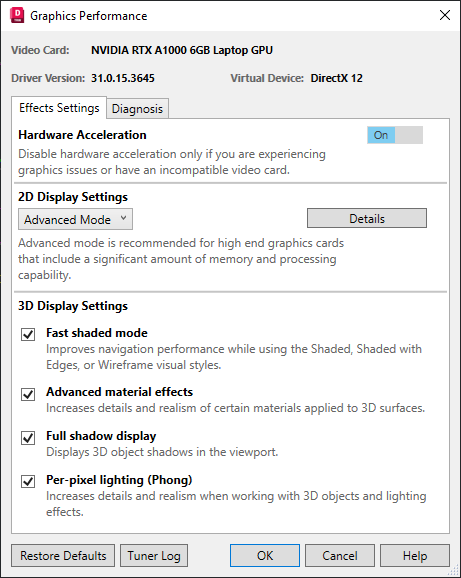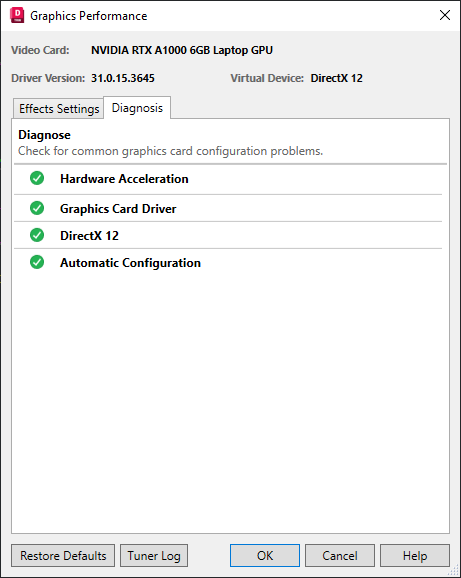These settings control hardware acceleration, effects available through your system's graphics card, and software performance settings.
Effects Settings
Displays options for hardware acceleration, as well as 2D and 3D display settings.

- Hardware Acceleration
- Enables the use of hardware acceleration and provides control to all effects settings available for the current driver. When off, only the smooth line display option is enabled and the mode switches to the default Software Mode.
- 2D Display Settings
- Enables the use of hardware acceleration and provides control to all effects settings available for the current driver. When off, only the smooth line display option is enabled.
- Mode Drop-down List
- Select an appropriate configuration mode based on your graphic card. By default, the advanced mode is selected for DirectX 12 graphic cards.
- Advanced Mode - Recommended for high end graphics cards that include a significant amount of memory and processing capability.
- Intermediate Mode - Recommended for mid-level graphics cards that have some processing capability but a limited amount of memory.
- Basic Mode - Recommended for entry-level graphics cards that have minimal processing capability and limited or no memory.
- Details/Hide Details Button
- Controls the display of 2D options. By default, smooth line display and video caching memory level options are collapsed in the display. Click on the Details button to view these options.
- Smooth Line Display - Controls the status of the full screen anti-aliasing effect. This option removes the jagged effect on the display of diagonal lines and curved edges.
- Video Memory Caching Level - With high end graphics cards, you can control the amount of video memory that will be used to cache graphics. A larger value will have better performance, unless other applications are also using video memory.
Note: It is recommended that you do not use any type of remote access application, such as Remote Desktop, or any other windows emulating software in conjunction with hardware acceleration. Most remote access applications do not support hardware acceleration, and as a result, can cause general display failure and instability. Prior to using a remote access application with an AutoCAD-based product, check with the software vendor to see if it supports hardware acceleration and if not, disable hardware acceleration prior to starting the remote access software or use the /NOHARDWARE command line switch to start an AutoCAD-based product in Software mode.
- 3D Display Settings
- Enables the use of hardware acceleration and provides control to all effects settings available for the current driver. When off, only the Smooth Line Display option is enabled.
- Fast Shaded Mode
- Controls whether the cross-platform 3D graphics system is turned on or off.
- Advanced Material Effects
- Controls the status of the advanced materials effect on-screen.
- Full Shadow Display
- Enables shadows to be displayed in the viewport.
- Per-Pixel Lighting (Phong)
- Enables the computation of colors for individual pixels. With this option turned on, the 3D objects and lighting effects appear smoother in the viewport.
Diagnosis Tab
Displays the status of the graphics card configuration, helping you troubleshoot performance or configuration issues.

Indicates no graphics performance problems.

Indicates issue, with actions to take to improve performance.

- Hardware Acceleration
- When hardware acceleration is off, this will result in lower performance.
- Graphics Card Driver
- This checks whether the graphics card driver is up to date.
- Dual Graphics Cards
- In the case of two graphics cards, make sure the higher performance graphics card is active.
- DirectX <version>
- Displays the version of DirectX your graphics card supports.
Note: Graphics cards must be DirectX 12 compatible to fully support AutoCAD features.
- High Resolution Display
- When the graphics card cannot fully support the resolution, reduce the resolution or update the graphics card.
- Automatic Configuration
- Check that automatic configuration is enabled. Remove the GS_DEVICE or GFXDX12 override to optimize performance.
Restore Defaults
Resets the values to the defaults based on the Graphics Performance’s evaluation of the graphics card.
Tuner Log
Displays the tuner log, which reads your system and decides whether to use software or hardware implementation for features that support both. Features that work with your system are turned on, and features that might not work with your system are turned off. A log file displays the results, including information about your graphics card.